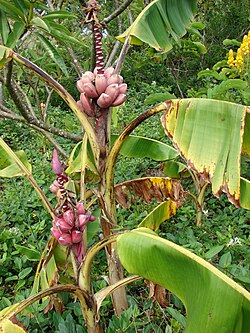From Wikipedia
Open on Wikipedia
| Musa velutina | |
|---|---|

| |
| Scientific classification | |
| Kingdom: | Plantae |
| Clade: | Tracheophytes |
| Clade: | Angiosperms |
| Clade: | Monocots |
| Clade: | Commelinids |
| Order: | Zingiberales |
| Family: | Musaceae |
| Genus: | Musa |
| Section: | Musa sect. Musa |
| Species: | M. velutina
|
| Binomial name | |
| Musa velutina H. Wendl. & Drude
| |
Musa velutina, the hairy banana[1] or pink banana, is a diploid species of wild banana.[2] These plants are originally from Assam and the eastern Himalayas.[3]
The fruits are 3 in (8 cm) long, pink, and fuzzy. They are borne on erect flower stalks with a pink inflorescence. Musa velutina flowers at a young age, doing so within a year. The fruits peel back when ripe.
It is often grown as an ornamental plant, but has soft, sweet flesh that can be eaten. The seeds are quite tough and can chip a tooth. To sow, first soak the seeds in warm water for 24 hours. They should be planted in fine compost and kept at a constant temperature of 20–24 °C (68–75 °F) with full natural light. They take up to around 6 months to germinate.[4]
Plants may be placed outside during warmer months but should be taken into a conservatory or greenhouse or given other protection in winter. Musa velutina has received the Royal Horticultural Society's Award of Garden Merit.[5]
Gallery
[edit]-
Seeds
References
[edit]- ^ NRCS. "Musa velutina". PLANTS Database. United States Department of Agriculture (USDA). Retrieved 15 July 2015.
- ^ Pancholi, Naresh; Wetten, A.; Caligari, P. D. S. (1995). "Germination of Musa velutina Seeds: Comparison of in vivo and in vitro Systems". In Vitro Cellular & Developmental Biology. Plant. 31 (3): 127–130. doi:10.1007/BF02632006. JSTOR 4293074. S2CID 27989888.
- ^ "Musa velutina". World Checklist of Selected Plant Families. Royal Botanic Gardens, Kew. Retrieved 2018-07-05.
- ^ "How to Germinate a Pink Banana Plant".
- ^ "Musa veltina". www.rhs.org. Royal Horticultural Society. Retrieved 3 January 2021.


